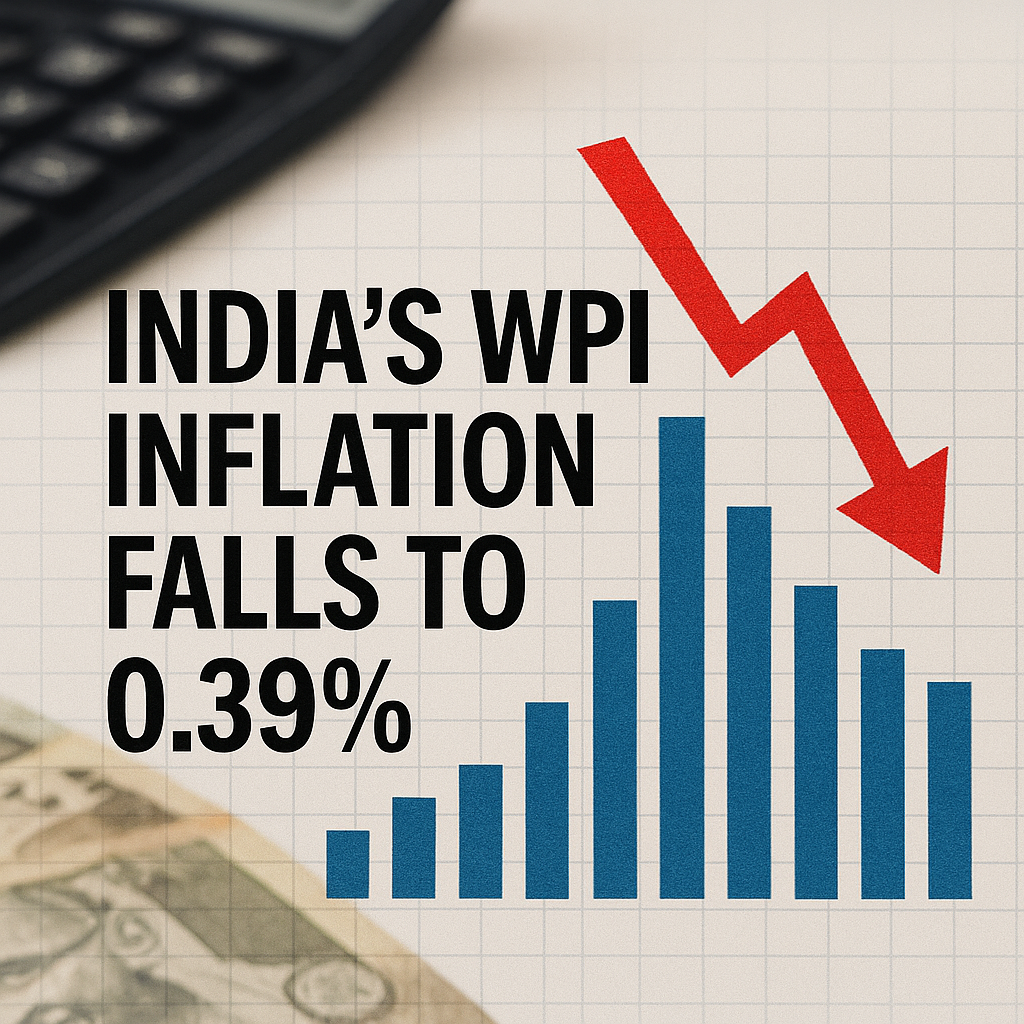
🧭June 13, 2025 Post 2: India’s WPI Inflation Falls to 0.39% — Broad-Based Disinflation | High Quality Mains Essay | Prelims MCQs
India’s WPI Inflation Falls to 0.39% — Broad-Based Disinflation

NATIONAL
📅 Post Date: June 13, 2025
📘 Thematic Focus: Economy | Inflation Trends | Monetary Policy Indicators
🌀 Opening Whisper
“When wholesale prices cool, the pulse of the economy beats calmly beneath the surface.”
🔍 Key Highlights
- India’s Wholesale Price Index (WPI) inflation for May 2025 eased to 0.39%, marking the lowest level in 14 months.
- The disinflation was broad-based, with price reductions observed in:
- Food articles (including cereals, onions, and pulses)
- Fuel and power (mainly petroleum and electricity)
- Manufactured products, especially chemicals and textiles
- This downward trend closely mirrors CPI inflation, which stood at 2.82% in May 2025.
- The data reinforces the RBI’s recent 50 basis point rate cut, supporting a dovish monetary stance.
- Experts highlight that soft WPI data also reduces cost-push inflationary risks for manufacturers and exporters.
📘 Concept Explainer: What is WPI and Why It Matters
- WPI measures price movements at the wholesale level, typically before goods reach the consumer.
- It is a key indicator for assessing supply-side inflation, input costs for businesses, and pricing pressures in the production chain.
- WPI trends often act as a precursor to retail inflation and can influence RBI’s inflation expectations framework.
🧭 GS Mains Mapping
- GS Paper 3 – Indian Economy: Inflation Trends, Price Indices, Monetary Policy
- GS Paper 2 – Role of Statutory Bodies like RBI in Price Stabilization
💭 A Thought Spark — by IAS Monk
“Inflation does not always roar; sometimes, it retreats quietly, giving breathing room to both policy and people.”
High Quality Mains Essay For Practice :
Word Limit 1000-1200
Disinflation in the Wholesale Market: A Breather for the Indian Economy
Introduction
In the symphony of economic indicators, inflation plays a particularly critical role. It influences the lives of individuals, the actions of central banks, and the health of enterprises. On June 13, 2025, data released by the Ministry of Commerce revealed that India’s Wholesale Price Index (WPI) inflation for May 2025 had dropped to a mere 0.39%—a 14-month low. This easing marks a period of broad-based disinflation, with reductions seen in the prices of food articles, fuel, and manufactured goods.
The trend reinforces a cooling inflationary environment, reflecting supply-side relief, subdued global commodity prices, and restrained domestic demand. This development not only supports the RBI’s recent dovish shift in monetary policy but also opens up a space for fiscal and corporate strategy realignment.
Understanding the Wholesale Price Index (WPI)
WPI is a price index that measures changes in the prices of goods sold and traded in bulk by wholesale businesses. Unlike the Consumer Price Index (CPI), which tracks the end-price paid by households, WPI reflects prices at the first point of sale in the supply chain. It provides crucial insight into cost-push inflation, or the impact of raw material and production costs on overall pricing.
Key Components of WPI:
- Primary Articles (22.6%) – Includes food grains, pulses, vegetables, and minerals
- Fuel & Power (13.2%) – Petroleum, electricity, coal
- Manufactured Products (64.2%) – Chemicals, textiles, metals, machinery
The May 2025 Snapshot: Disinflation Unfolds
India’s WPI inflation declined from 1.14% in April to 0.39% in May 2025, continuing a downward trend for the fourth consecutive month.
Sectoral Highlights:
- Food Articles:
- Vegetable prices (especially onions and tomatoes) saw sharp month-on-month declines due to improved supply and early monsoon arrivals.
- Pulses and cereals also witnessed minor corrections.
- Fuel & Power:
- A temporary dip in global crude prices earlier in May contributed to reduced wholesale fuel prices.
- Electricity tariffs remained stable amidst restrained industrial consumption.
- Manufactured Products:
- Lower input costs and easing global commodity prices led to cheaper production in sectors like fertilizers, cement, and base metals.
What’s Driving the Disinflation?
1. Global Commodity Stabilization
After a volatile 2023, global supply chains have stabilized. Prices of base metals, food grains, and crude oil temporarily softened in early Q2 of 2025, offering relief to Indian producers.
2. Monsoon Expectations
The Indian Meteorological Department has forecast a normal monsoon, improving the outlook for agricultural production. This expectation has contributed to lower forward pricing by wholesalers.
3. Domestic Demand Moderation
While economic growth remains steady, consumer demand remains muted in some segments due to cautious spending patterns. This has led manufacturers to avoid aggressive price hikes.
4. Policy Efficacy
Supply-side reforms such as logistics modernization under Gati Shakti, digital mandi networks, and better warehousing have improved food distribution efficiency, reducing spoilage and inflationary pressures.
Implications for the Indian Economy
A. Validation of RBI’s Dovish Monetary Turn
The RBI had recently cut the repo rate by 50 basis points, citing subdued inflation as a cushion. The sharp WPI fall reinforces this stance, allowing room for accommodative monetary policy in the near term.
B. Lower Input Costs for Industry
Manufacturers, especially MSMEs and exporters, benefit from reduced raw material prices. This enhances margins, fosters pricing competitiveness, and boosts job creation.
C. Easing of Fiscal Pressures
Lower wholesale inflation translates into moderated subsidy outflows for food and fertilizers. It also provides the government more fiscal room for capital expenditure without stoking inflation.
D. Improved Trade Competitiveness
With input costs easing and the rupee stabilizing, Indian exports—especially in textiles, chemicals, and engineering goods—are likely to remain competitive in global markets.
Relationship Between WPI and CPI
Though both measure inflation, WPI and CPI often diverge due to:
- Coverage: WPI excludes services; CPI includes them.
- Weighting: Food has more weight in CPI; manufacturing dominates WPI.
- Price Level: WPI tracks ex-factory/wholesale prices; CPI reflects retail end-prices.
Yet, in May 2025, both indices moved in tandem—CPI fell to 2.82%, reinforcing the signal of broad-based inflation control.
Risks to the Disinflationary Trend
1. Oil Price Volatility
While crude prices temporarily softened in early May, tensions in the Middle East have resurged in June, threatening a reversal.
2. Food Price Spikes
Any delay or shortfall in monsoon could reintroduce volatility in vegetable and grain prices, especially onions and pulses.
3. Global Commodity Uncertainty
Unexpected supply chain disruptions, geopolitical escalations, or changes in trade policy could again lift wholesale prices.
Way Forward: Policy Recommendations
1. Monetary Vigilance
RBI must continue its data-dependent approach, ensuring inflation remains within the 4% ±2% tolerance band while supporting growth.
2. Food Logistics Investment
Improved cold chains, warehouse digitization, and real-time mandi price tracking can ensure sustained food price stability.
3. Export-Linked Support
Lower WPI should be leveraged to boost production-linked incentives and capitalize on cost advantages in global markets.
4. Monitoring Core Inflation
Even as headline WPI eases, core manufacturing inflation needs to be watched to assess long-term pricing dynamics and wage pressure risks.
Conclusion
India’s wholesale disinflation to 0.39% is more than a statistical footnote—it is a macroeconomic opportunity. It suggests not only cooling supply-side costs but also a moment to recalibrate policy levers. As CPI aligns with WPI and inflation enters a phase of moderation, India finds itself in a unique position: strong monetary credibility, stable price environment, and headroom for economic expansion.
Yet, the gains must be guarded. Disinflation today can quickly give way to volatility tomorrow. Policymakers must remain agile, industries must prepare for global shifts, and citizens must feel the benefits not just at the supply chain—but at their local kirana shops.
In the quiet retreat of wholesale inflation, the economy hears a pause—an invitation to breathe, regroup, and rebuild wisely.
Target IAS-26: Daily MCQs :
📌 Prelims Practice MCQs
Topic: India’s WPI Inflation Falls to 0.39% — Broad-Based Disinflation
MCQ 1 – Type 1: How many of the above statements are correct?
Consider the following statements regarding the May 2025 WPI inflation data:
1. WPI inflation dropped to a 14-month low of 0.39% in May 2025.
2. The decline was driven primarily by rising fuel prices and an increase in core inflation.
3. The WPI trend closely mirrors CPI inflation, which also fell in May 2025.
4. RBI’s recent 50 bps repo rate cut was announced before the WPI data release.
How many of the above statements are correct?
A) Only one
B) Only two
C) Only three
D) All four
🌀 Didn’t get it? Click here (▸) for the Correct Answer & Explanation
✅ Correct Answer: B) Only two
🧠 Explanation:
1) ✅ True – WPI dropped to 0.39%, a 14-month low.
2) ❌ False – The decline was driven by falling, not rising, fuel prices and broad-based disinflation, not core inflation rise.
3) ✅ True – CPI also declined to 2.82%, mirroring WPI trends.
4) ❌ False – The RBI rate cut came after earlier inflation data, not before this WPI update.
MCQ 2 – Type 2: Two Statements Based
Consider the following two statements:
1. The Wholesale Price Index includes services, while the Consumer Price Index does not.
2. WPI inflation affects input costs and thus impacts manufacturers more directly than CPI.
Which of the above statements is/are correct?
A) Only 1 is correct
B) Only 2 is correct
C) Both are correct
D) Neither is correct
🌀 Didn’t get it? Click here (▸) for the Correct Answer & Explanation
✅ Correct Answer: C) Both are correct
🧠 Explanation:
1) ❌ False – WPI does not include services; CPI does.
2) ✅ True – WPI captures wholesale price trends, directly influencing production and manufacturing costs.
MCQ 3 – Type 3: Which of the statements is/are correct?
Which of the following contributed to the fall in WPI inflation in May 2025?
1. Decline in food prices
2. Stable electricity tariffs
3. Increased consumer demand
4. Lower global commodity prices
Select the correct code:
A) 1, 2, and 4 only
B) 2 and 3 only
C) 1 and 3 only
D) 1, 2, 3, and 4
🌀 Didn’t get it? Click here (▸) for the Correct Answer & Explanation
✅ Correct Answer: A) 1, 2, and 4 only
🧠 Explanation:
1) ✅ True – Vegetable and food prices fell.
2) ✅ True – Electricity tariffs remained largely unchanged.
3) ❌ False – Demand was muted, not increased.
4) ✅ True – Soft global commodity prices helped reduce input costs.
MCQ 4 – Type 4: Direct Fact
What is the weightage of ‘Manufactured Products’ in the Wholesale Price Index (WPI)?
A) 22.6%
B) 13.2%
C) 64.2%
D) 40.5%
🌀 Didn’t get it? Click here (▸) for the Correct Answer & Explanation.
✅ Correct Answer: C) 64.2%
🧠 Explanation:
• Manufactured Products have the highest weightage in WPI at 64.2%, followed by Primary Articles (22.6%) and Fuel & Power (13.2%)..


















